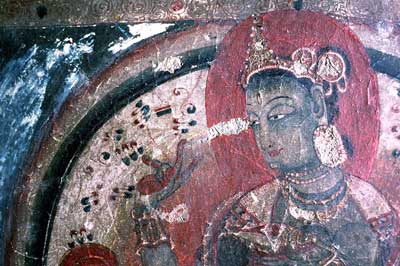
The Nako Temple Complex is remarkable for the extent and importance of
its early Buddhist wall paintings which, according to latest research, are dated to the early 12th century. Geographic isolation in the Western Himalayas has had mixed consequences for the preservation of the four temples and their paintings. In neighbouring Tibet, most comparable wall paintings were destroyed in
the 1960s and 70s, while in India other temple murals have been recently
over-painted. Fortunately, the Nako temples have escaped these events, but
the simple mud-brick buildings have poorly withstood harsh environmental
conditions. These include the effects of a major earthquake in 1975.
As a result, the wall paintings have been extensively destabilised, parts have been lost or badly restored, and all are now at great risk. Their ongoing vulnerability has been recognised by the World Monuments Fund, and a long-term conservation plan is being proposed by the Nako Preservation Project (NPP). Recently, the NPP approached the Courtauld Institute (University of London) with a view to undertaking a collaborative project to conserve the wall paintings. In response to this, a preliminary inspection of the site was made by Stephen Rickerby in August 2002. This had three main components:
The particular circumstances at Nako have led to two main types of wall painting damage:
major and widespread cracking, detachment and loss of the plaster layers;
and extensive rainwater and snowmelt infiltration deposits,
which have both obscured and washed away much painting. In addition,
the paintings are affected by different forms of deterioration – such as
widespread lifting of the upper paint layers in the largest temple – relating
probably to the interaction between the original paint materials and
the prevailing environment, both of which remain to be fully examined.
It is clear that a major conservation programme is necessary,
which would primarily involve large-scale
stabilisation work. However, it is also clear that the paintings
are technically complex, and that they face a matching range
of complex conservation problems. These factors – and the importance
of the paintings – make it essential that the conservation programme is
conducted on a basis of appropriate condition assessment and recording,
scientific investigation of the original construction and paint materials,
and necessary investigations of environmental and deterioration risks.
Following the commencement of these activities in 2003, it is anticipated
that the treatment of the wall paintings could begin in spring 2004.
Stephen Rickerby
January 2003
